Xing Yu
Towards Agentic Self-Learning LLMs in Search Environment
Oct 16, 2025Abstract:We study whether self-learning can scale LLM-based agents without relying on human-curated datasets or predefined rule-based rewards. Through controlled experiments in a search-agent setting, we identify two key determinants of scalable agent training: the source of reward signals and the scale of agent task data. We find that rewards from a Generative Reward Model (GRM) outperform rigid rule-based signals for open-domain learning, and that co-evolving the GRM with the policy further boosts performance. Increasing the volume of agent task data-even when synthetically generated-substantially enhances agentic capabilities. Building on these insights, we propose \textbf{Agentic Self-Learning} (ASL), a fully closed-loop, multi-role reinforcement learning framework that unifies task generation, policy execution, and evaluation within a shared tool environment and LLM backbone. ASL coordinates a Prompt Generator, a Policy Model, and a Generative Reward Model to form a virtuous cycle of harder task setting, sharper verification, and stronger solving. Empirically, ASL delivers steady, round-over-round gains, surpasses strong RLVR baselines (e.g., Search-R1) that plateau or degrade, and continues improving under zero-labeled-data conditions, indicating superior sample efficiency and robustness. We further show that GRM verification capacity is the main bottleneck: if frozen, it induces reward hacking and stalls progress; continual GRM training on the evolving data distribution mitigates this, and a small late-stage injection of real verification data raises the performance ceiling. This work establishes reward source and data scale as critical levers for open-domain agent learning and demonstrates the efficacy of multi-role co-evolution for scalable, self-improving agents. The data and code of this paper are released at https://github.com/forangel2014/Towards-Agentic-Self-Learning
DeepEyes: Incentivizing "Thinking with Images" via Reinforcement Learning
May 20, 2025Abstract:Large Vision-Language Models (VLMs) have shown strong capabilities in multimodal understanding and reasoning, yet they are primarily constrained by text-based reasoning processes. However, achieving seamless integration of visual and textual reasoning which mirrors human cognitive processes remains a significant challenge. In particular, effectively incorporating advanced visual input processing into reasoning mechanisms is still an open question. Thus, in this paper, we explore the interleaved multimodal reasoning paradigm and introduce DeepEyes, a model with "thinking with images" capabilities incentivized through end-to-end reinforcement learning without the need for cold-start SFT. Notably, this ability emerges natively within the model itself, leveraging its inherent grounding ability as a tool instead of depending on separate specialized models. Specifically, we propose a tool-use-oriented data selection mechanism and a reward strategy to encourage successful tool-assisted reasoning trajectories. DeepEyes achieves significant performance gains on fine-grained perception and reasoning benchmarks and also demonstrates improvement in grounding, hallucination, and mathematical reasoning tasks. Interestingly, we observe the distinct evolution of tool-calling behavior from initial exploration to efficient and accurate exploitation, and diverse thinking patterns that closely mirror human visual reasoning processes. Code is available at https://github.com/Visual-Agent/DeepEyes.
Less is More: Enhancing Structured Multi-Agent Reasoning via Quality-Guided Distillation
Apr 23, 2025Abstract:The XLLM@ACL2025 Shared Task-III formulates a low-resource structural reasoning task that challenges LLMs to generate interpretable, step-by-step rationales with minimal labeled data. We present Less is More, the third-place winning approach in the XLLM@ACL2025 Shared Task-III, which focuses on structured reasoning from only 24 labeled examples. Our approach leverages a multi-agent framework with reverse-prompt induction, retrieval-augmented reasoning synthesis via GPT-4o, and dual-stage reward-guided filtering to distill high-quality supervision across three subtasks: question parsing, CoT parsing, and step-level verification. All modules are fine-tuned from Meta-Llama-3-8B-Instruct under a unified LoRA+ setup. By combining structure validation with reward filtering across few-shot and zero-shot prompts, our pipeline consistently improves structure reasoning quality. These results underscore the value of controllable data distillation in enhancing structured inference under low-resource constraints. Our code is available at https://github.com/Jiahao-Yuan/Less-is-More.
Think When You Need: Self-Adaptive Chain-of-Thought Learning
Apr 04, 2025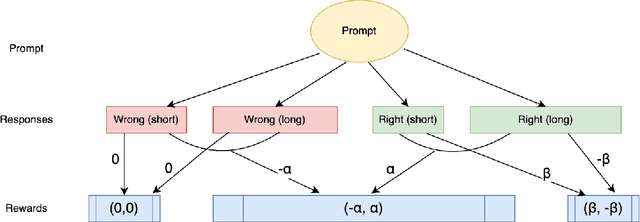
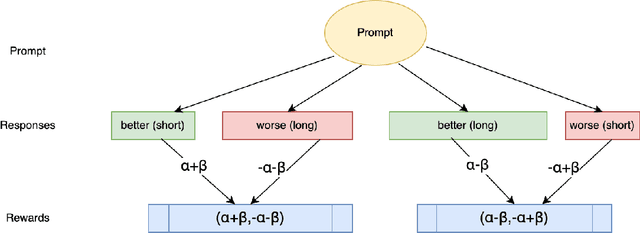


Abstract:Chain of Thought (CoT) reasoning enhances language models' performance but often leads to inefficient "overthinking" on simple problems. We identify that existing approaches directly penalizing reasoning length fail to account for varying problem complexity. Our approach constructs rewards through length and quality comparisons, guided by theoretical assumptions that jointly enhance solution correctness with conciseness. Moreover, we further demonstrate our method to fuzzy tasks where ground truth is unavailable. Experiments across multiple reasoning benchmarks demonstrate that our method maintains accuracy while generating significantly more concise explanations, effectively teaching models to "think when needed."
Probabilistic Uncertain Reward Model: A Natural Generalization of Bradley-Terry Reward Model
Mar 28, 2025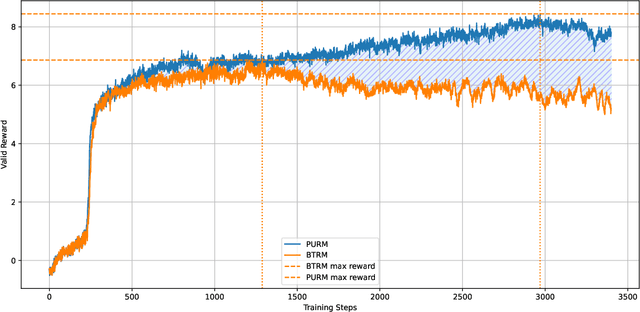
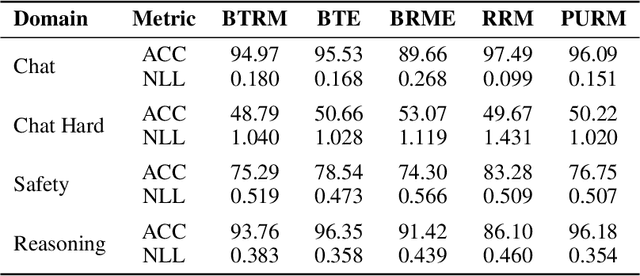
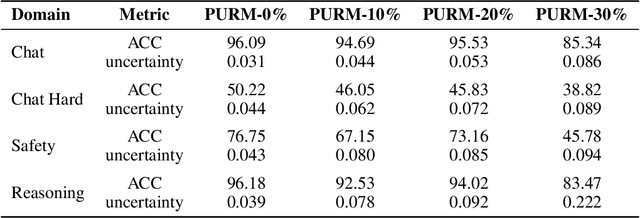
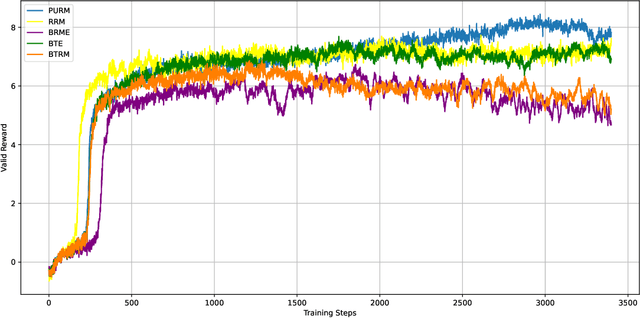
Abstract:Reinforcement Learning from Human Feedback (RLHF) has emerged as a critical technique for training large language models. However, reward hacking-a phenomenon where models exploit flaws in the reward model-remains a significant barrier to achieving robust and scalable intelligence through long-term training. Existing studies have proposed uncertain reward model to address reward hacking, however, they often lack systematic or theoretical foundations, failing to model the uncertainty intrinsically emerging from preference data. In this paper, we propose the Probabilistic Uncertain Reward Model (PURM), a natural generalization of the classical Bradley-Terry reward model. PURM learns reward distributions directly from preference data and quantifies per-sample uncertainty via the average overlap area between reward distributions. To mitigate reward hacking, we further introduce an uncertainty-aware penalty into Proximal Policy Optimization (PPO), which leverages the learned uncertainty to dynamically balance reward optimization and exploration. We propose a lightweight and easy-to-use implementation of PURM. Experiments demonstrate that PURM significantly delays the onset of reward hacking while improving final reward performance, outperforming baseline methods in both stability and effectiveness.
Cheems: A Practical Guidance for Building and Evaluating Chinese Reward Models from Scratch
Feb 24, 2025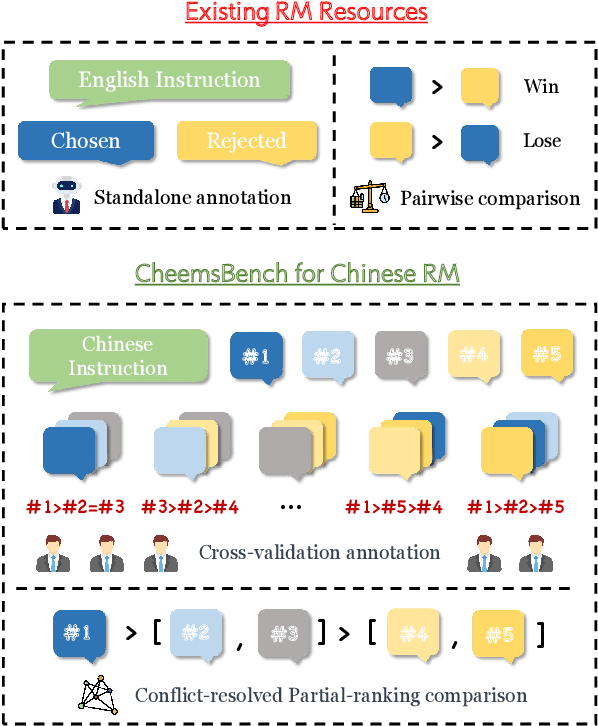

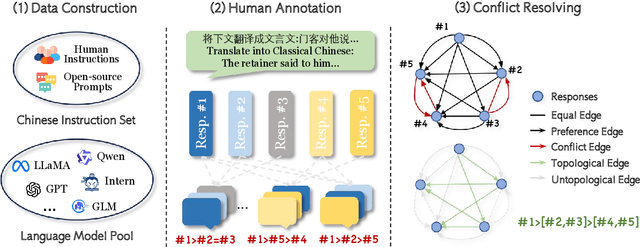
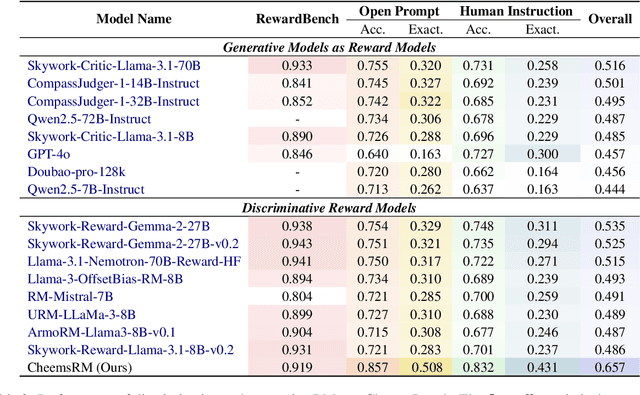
Abstract:Reward models (RMs) are crucial for aligning large language models (LLMs) with human preferences. However, most RM research is centered on English and relies heavily on synthetic resources, which leads to limited and less reliable datasets and benchmarks for Chinese. To address this gap, we introduce CheemsBench, a fully human-annotated RM evaluation benchmark within Chinese contexts, and CheemsPreference, a large-scale and diverse preference dataset annotated through human-machine collaboration to support Chinese RM training. We systematically evaluate open-source discriminative and generative RMs on CheemsBench and observe significant limitations in their ability to capture human preferences in Chinese scenarios. Additionally, based on CheemsPreference, we construct an RM that achieves state-of-the-art performance on CheemsBench, demonstrating the necessity of human supervision in RM training. Our findings reveal that scaled AI-generated data struggles to fully capture human preferences, emphasizing the importance of high-quality human supervision in RM development.
Rethinking Reward Model Evaluation: Are We Barking up the Wrong Tree?
Oct 08, 2024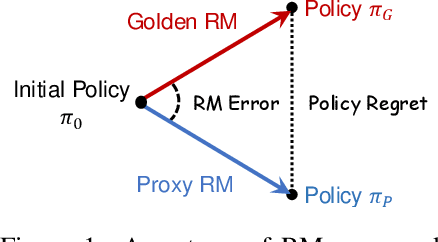



Abstract:Reward Models (RMs) are crucial for aligning language models with human preferences. Currently, the evaluation of RMs depends on measuring accuracy against a validation set of manually annotated preference data. Although this method is straightforward and widely adopted, the relationship between RM accuracy and downstream policy performance remains under-explored. In this work, we conduct experiments in a synthetic setting to investigate how differences in RM measured by accuracy translate into gaps in optimized policy performance. Our findings reveal that while there is a weak positive correlation between accuracy and downstream performance, policies optimized towards RMs with similar accuracy can exhibit quite different performance. Moreover, we discover that the way of measuring accuracy significantly impacts its ability to predict the final policy performance. Through the lens of Regressional Goodhart's effect, we identify the existence of exogenous variables impacting the relationship between RM quality measured by accuracy and policy model capability. This underscores the inadequacy of relying solely on accuracy to reflect their impact on policy optimization.
Machine Learning Parameterization of the Multi-scale Kain-Fritsch (MSKF) Convection Scheme
Nov 07, 2023



Abstract:Warm-sector heavy rainfall often occurs along the coast of South China, and it is usually localized and long-lasting, making it challenging to predict. High-resolution numerical weather prediction (NWP) models are increasingly used to better resolve topographic features and forecast such high-impact weather events. However, when the grid spacing becomes comparable to the length scales of convection, known as the gray zone, the turbulent eddies in the atmospheric boundary layer are only partially resolved and parameterized to some extent. Whether using a convection parameterization (CP) scheme in the gray zone remains controversial. Scale-aware CP schemes are developed to enhance the representation of convective transport within the gray zone. The multi-scale Kain-Fritsch (MSKF) scheme includes modifications that allow for its effective implementation at a grid resolution as high as 2 km. In recent years, there has been an increasing application of machine learning (ML) models to various domains of atmospheric sciences, including the replacement of physical parameterizations with ML models. This work proposes a multi-output bidirectional long short-term memory (Bi-LSTM) model as a replace the scale-aware MSKF CP scheme. The Weather Research and Forecast (WRF) model is used to generate training and testing data over South China at a horizontal resolution of 5 km. Furthermore, the WRF model is coupled with the ML based CP scheme and compared with WRF simulations with original MSKF scheme. The results demonstrate that the Bi-LSTM model can achieve high accuracy, indicating the potential use of ML models to substitute the MSKF scheme in the gray zone.
 Add to Chrome
Add to Chrome Add to Firefox
Add to Firefox Add to Edge
Add to Edge